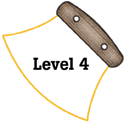
Alaska Science
Key Element A11
 |
Alaska Science |
|
Performance Standard Level 4, Ages 15–18
|
|
|
|
Sample Assessment Ideas
|
Standards Cross-References
|
||
|
National Science Education Standards In all organisms, the instructions for specifying the characteristics of the organism are carried in DNA, a large polymer formed from subunits of four kinds (A, G, C, and T). The chemical and structural properties of DNA explain how the genetic information that underlies heredity is both encoded in genes (as a string of molecular “letters”) and replicated (by a templating mechanism). Each DNA molecule in a cell forms a single chromosome. (Page 185) Most of the cells in a human contain two copies of each of 22 different chromosomes. In addition, there is a pair of chromosomes that determines sex: a female contains two X chromosomes and a male contains one X and one Y chromosome. Transmission of genetic information to offspring occurs through egg and sperm cells that contain only one representative from each chromosome pair. An egg and a sperm unite to form a new individual. The fact that the human body is formed from cells that contain two copies of each chromosome-and therefore two copies of each gene—explains many features of human heredity, such as how variations that are hidden in one generation can be expressed in the next. (Page 185) Changes in DNA (mutations) occur spontaneously at low rates. Some of these changes make no difference to the organism, whereas others can change cells and organisms. Only mutations in germ cells can create the variation that changes an organism’s offspring. (Page 185) |
Benchmarks Some new gene combinations make little difference, some can produce organisms with new and perhaps enhanced capabilities, and some can be deleterious. (Page 108) The sorting and recombination of genes in sexual reproduction results in a great variety of possible gene combinations from the offspring of any two parents. (Page 108) The information passed from parents to offspring is coded in DNA molecules. (Page 108) Genes are segments of DNA molecules. Inserting, deleting, or substituting DNA segments can alter genes. An altered gene may be passed on to every cell that develops from it. The resulting features may help, harm, or have little or no effect on the offspring’s success in its environment. (Page 109) Gene mutations can be caused by such things as radiation and chemicals. When they occur in sex cells, the mutations can be passed on to offspring; if they occur in other cells, they can be passed on to descendant cells only. The experiences an organism has during its lifetime can affect its offspring only if the genes in its own sex cells are changed by the experience. (Page 109) The many body cells in an individual can be very different from one another, even though they are all descended from a single cell and thus have essentially identical genetic instructions. Different parts of the instructions are used in different types of cells, influenced by the cell’s environment and past history. (Page 109) |
|
Table of Contents | Return to Alaska Native Knowledge Network